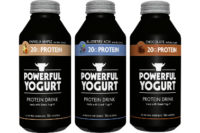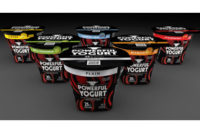
Powerful Protein
by Lori Dahm
Whey continues to expand its value beyond dairy.
Whey ingredients have been
on the radar of the dairy industry for the past several years, both because
of the many emerging health attributes being discovered with regard to
whey, as well as the functional improvements that whey ingredients can
deliver in new products.
At last, it seems that whey is coming into its own as
an ingredient; numerous innovative new beverage products are using whey to
deliver an amplified protein content, and whey is also being used in many
of the newest trendy product formulations for its properties as a fat
replacer. At the same time, the emerging health attributes that whey
delivers continue to be researched, documented and published. These
discoveries are fuel for more momentum and excitement surrounding the
possibilities of whey.
All told, the whey story continues to be one of growing
promise within the dairy industry, as the latest research into product
applications and health benefits are further brightening the halo around
this once unwanted and unused byproduct of dairy manufacturing.
In the Market
Improvements in whey ingredients have been a major
focus of development within the whey supply market within the past year.
Most notably, whey proteins that are clear and water soluble have paved the
road for the introduction of new protein waters which contain whey.
For the specialized niche of the body-builder athlete,
a protein water beverage that boasts 20 grams of protein, delivered by a
whey ingredient, was introduced by Stacker 2, Andover, N.J., in 2006. A
more mainstream example introduced in June came from Kellogg’s,
Battle Creek, Mich. Kellogg’s Special K20 Protein Waters use whey
ingredients as the protein source, and each 16-ounce bottle offers 5 grams
of protein and only 50 calories, in three flavor varieties: Strawberry
Kiwi, Lemon Twist and Tropical Blend.
“Some of the most innovative new products using
whey are the protein waters, which have spilled out of the sports-nutrition
beverage market to become more mainstream and appeal to the general
consumer,” says Eric Bastian, director of research and development at
Glanbia Foods Inc., Twin Falls, Idaho. “These clear beverages, which
must be clear in order to be labeled as ‘water,’ certainly have
lower levels of protein than the sports-nutrition beverages that are
developed to deliver the biggest slug of protein possible in a beverage.
These new protein waters still manage to offer the benefits of a high
protein load in a form which highlights the clarity of the beverage
product.”
The latest iterations upon whey ingredients allow for
improved solubility in beverages in the clear water format, but also in
other beverage applications with a wider range of pH levels than was
previously possible. This is a new development; until the past year, whey
ingredients were most easily used only in low-pH beverages such as
smoothies and yogurt drinks because the protein would settle out of
solution in the mid- and high-pH beverage applications.
“We have some proprietary whey ingredients
developed for the mid- and neutral-pH range because, in general, whey
protein products have not proven as stable in those environments,”
Bastian says. “We have worked to develop a 100 percent whey protein
product that can be part of a neutral pH product without negative effects
that typically correspond to those environments. Our newest whey protein
ingredients can go through aseptic heat treatment without having the
protein denature, aggregate and fall out into a sludge at the bottom of the
beverage container.”
Again, a product that hails from the sports-nutrition
realm is Muscle Milk, a neutral-pH beverage that uses whey protein isolate
and casein to amplify the protein content. Muscle Milk boasts 30 grams of
protein and is billed as the ideal supplement beverage to consume before a
workout for maximum muscle build and low body fat.
Speaking of fat, another new and innovative use for
whey ingredients within the past year which has more relevance to the
mainstream market than the athlete niche was Slow Churned ice cream from
Dreyer’s/Edy’s.
“Whey protein is a great fat replacer, and in
November Edy’s came out with a Slow Churned Peanut Butter ice cream
that has whey protein in it,” says Sharon Gerdes, technical support
consultant at Dairy Management Inc. (DMI), Rosemont, Ill. “Then in
December, in the prepared meal category, there was an introduction of a
chicken and alfredo product that included whey protein in the pasta sauce,
utilizing the functional attributes whey imparts to microwave meals. Whey
proteins are being used in new formulations that span many
categories.”
Lowfat yogurts are another new product incorporating
whey for its ability to function as an effective fat replacer, and, of
course, nutrition and energy bars continue to be a prime category using
whey as an ingredient for its high protein content.
“The reason whey is used so often in bar
applications is because it offers a beneficial texture for extrusion
purposes, although a problem is that some whey proteins will eventually
cause hardness in the bar over its shelf life,” Bastian says.
“We have done much development work to create whey ingredients that
maintain the rheology that is desired for extrusion of the bars and will at
the same time maintain the softness throughout the shelf life of the
bar.”
Whey has been exported for some time, and this is also
starting to become a bigger market opportunity.
“Global perception of whey concentrates being an
excellent source of protein has improved to the point that many overseas
governments are including WPC80 in school breakfast rations,” says
Peter Gutierrez, international sales director at Agri-Mark Dairy Proteins,
Onalaska, Wis. “This is especially surprising when one considers the
increasing amount of WPC being sent to Third World countries.”
Other novel new products that incorporate whey include
a new sports gel that includes whey as the protein source, and
Biochem’s Organic Greens and Whey Powder, which incorporates
“organic greens” and whey protein isolate.
“There are several reasons that whey ingredients
are being used in more and better products, but it comes down to the
multiple benefits delivered by whey: flavor, function and nutrition,”
Gerdes says. “There were over 6,000 new products introduced last year
that include whey ingredients. Across the board, whey is so versatile
— it’s a high-quality source of protein and nutrition, and
delivers valuable functional benefits in applications.”
To Your Health
The health story behind whey is no small potatoes,
either. The effect of whey upon muscle synthesis, muscle accretion and the
maintenance of lean muscle mass is relatively well known in the industry,
and this effect certainly has been embraced by the body-builder athlete
community.
Breaking research news centers upon the satiety
benefits that are delivered by whey protein, and emerging science and
research is pointing toward blood pressure regulation being possible due to
whey.
“One of the most exciting areas of recent
research upon the health benefits of whey protein was a recently published
study about hypertension demonstrating that hydrolyzed whey protein has
blood pressure-lowering effects,” says Pete Huth, director of
regulatory affairs at DMI. “Hydrolyzed whey protein is whey that has
been enzymatically treated to release bioactive peptides. Study subjects
who were fed 20 grams of hydrolyzed whey protein per day had significantly
reduced diastolic and systolic blood pressure.”
The peptides produced in the hydrolization of whey
improve the ability of the blood vessels walls to dilate, through the
inhibition of angiotensin converting enzyme (ACE), an enzyme responsible
for blood vessel constriction. It is believed this is the reason for the
positive effect upon blood pressure in these studies.
Other emerging areas are suggesting that whey protein
may also be beneficial in impacting glucose and insulin response in people
who are pre-diabetic (often called metabolic syndrome) and are experiencing
insulin resistance.
The final frontier for whey research studies and the
dissemination of that information to consumers at large may lie at the
hands of the government. There is an imminent need for official labeling
claims for whey if this ingredient is going to gain the necessary
credibility to be widely accepted by consumers.
“Everyone wants to make a strong label claim for
whey, and that is where the science and the regulatory will have to come
together in the near future. For example, in the area of weight management,
there are numerous studies demonstrating whey’s beneficial
benefits,” Bastian says. “The Federal Trade Commission is
looking closely at statements being made related to weight management, and
this is one of the most critical issues today. So from a regulatory
standpoint, it is imperative to ensure there is proper documentation before
a claim can be made on the label.”
Whey and Satiety
Emerging research points to
a potential new role for whey protein: helping people feel full longer so
that they eat less.
In a recent study led by Dr. G. Harvey Anderson,
professor of nutritional sciences at the University of Toronto, healthy
young men were given a 200-calorie beverage containing about 45 grams of
sweet whey protein one hour before a pizza meal. This whey protein beverage
more effectively reduced the amount of pizza that study participants
consumed afterwards than did equivalent amounts of carbohydrates, egg
protein or water (the control). Whey protein “suppresses short-term
food intake and stimulates satiety mechanisms,” Anderson said this
past summer at a symposium sponsored by Dairy Management Inc. at the IFT
Annual Meeting and Food Expo.
Further research is needed, possibly centering on the
effect of the glycomacropeptide contained in sweet whey protein, Anderson
said. In addition, Anderson would like to investigate the dose most
effective for the satiating effect.
To learn more about nutritional benefits of whey
protein and formulating products with whey ingredients, visit
www.innovatewithdairy.com
$OMN_arttitle="Powerful Protein";?>
$OMN_artauthor="Lori Dahm";?>

